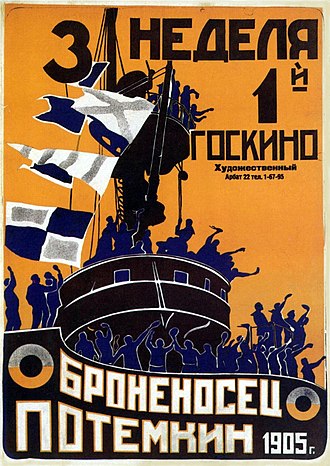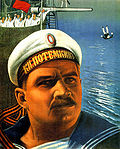Battleship Potemkin
Battleship Potemkin (Russian: Бронено́сец «Потёмкин», Bronenosets Potyomkin), sometimes spelled as Battleship Potyomkin is a 1925 silent drama Russian movie directed by Sergei Eisenstein. The movie is about a ship crew rebelling against their officers on the Battleship Potemkin and the events that follow. The film is often considered one of the best movies ever made.[1][2]
| Battleship Potemkin | |
|---|---|
 Original Soviet release poster | |
| Directed by | Sergei Eisenstein |
| Produced by | Jacob Bliokh |
| Written by |
|
| Starring |
|
| Music by | Various, including
|
| Cinematography |
|
| Edited by |
|
Production company | |
| Distributed by | Goskino |
Release date |
|
Running time | 75 minutes |
| Country | Soviet Union |
| Language |
|
Plot
The film is set in 1905 and is divided into five acts. The Potemkin is part of the Imperial Russian Navy's Black Sea Fleet.
Act 1: Men and Maggots
This opening act shows the poor conditions of the crew. Matyushenko and Vakulinchuk are two sailors who talk about the revolution. They want the sailors of the ship to join the revolution. Sailors are sleeping in their hammocks, and an officer beats a sailor. On deck, there appears to be rotten meat. The sailors complain about it and their low rations and refuse to eat it.
Act II: Drama on the Deck
The men who did not eat meat are ordered to be killed by a firing squad. The sailors with rifles lower their weapons and do not shoot. This is when the uprising starts. Sailors throw officers overboard and take over the ship. However, the leader Vakulinchuk is killed.
Act III: A Dead Man Calls Out
The Potemkin goes to the shores of Odessa. Sailors display Vakulinchuk's body in public. The people are sad but inspired. They start getting upset about the Tsar and his government. The sailors say goodbye and praise Vakulinchuk as a hero.
Act IV: The Odessa Steps
Many people have come to see the sailors and say goodbye. Suddenly soldiers (Cossack) start shooting at the people on the steps. They continue to march down the steps and shoot at men, women, and children. A baby carriage rolls down the steps, and a woman shot in the face with broken glasses is shown. The people cry out to the soldiers. In response, sailors of Potemkin shoot at the Opera House. There was a meeting there with Tsarist military leaders.
Act V: One Against All
The sailors go out into the sea to face the fleet of the Tsar. The sailors of the other ships do not open fire. Instead, they cheer the Potemkin on.
Cast
- Aleksandr Antonov as Grigory Vakulinchuk (Bolshevik sailor)
- Vladimir Barsky as Commander Golikov
- Grigori Aleksandrov as Chief Officer Giliarovsky
- I. Bobrov as Young sailor flogged while sleeping
- Mikhail Gomorov as Militant sailor
- Aleksandr Levshin as Petty Officer
- N. Poltavseva as Woman with pince-nez
- Lyrkean Makeon as the Masked Man
- Konstantin Feldman as Student agitator
- Beatrice Vitoldi as Woman with the baby carriage
Style
Eisenstein wanted the movie to be a propaganda film.[3] Eisenstein wanted viewers to feel sorry for the sailors and support their rebellion. The film was created very emotionally. This was so viewers could sympathize with the characters. Eisenstein uses a lot of montage editing to create emotional effects.[4] Eisenstein was unhappy that not many people watched the movie in Russia.[5]
The Odessa Steps sequence
The Odessa Steps sequence is a very famous scene in cinema.[6] It is a classic example of montage theory. It has influenced other movies.[7][8]
Many other movies reference to or parody the scene.[9]
Films that refer to the scene:
- Terry Gilliam's Brazil,
- Brian De Palma's The Untouchables,[10]
- George Lucas's Star Wars: Episode III – Revenge of the Sith,[11]
- Tibor Takacs's Deathline,
- Laurel and Hardy's The Music Box,
- Chandrashekhar Narvekar's Hindi film Tezaab,
- Shukō Murase's anime Ergo Proxy,
- Peter Sellers' The Magic Christian,
- The Children Thief,
- Johnnie To's Three
- Ettore Scola's We All Loved Each Other So Much.
Films that parody the scene:
- Woody Allen's Bananas and Love and Death;
- Zucker, Abrahams, and Zucker's Naked Gun 33⅓: The Final Insult (though also a parody of The Untouchables);
- the Soviet-Polish comedy Deja Vu;
- Jacob Tierney's The Trotsky;
- The short film Mr. Bill Goes to Washington;
- The German-Turkish film Kebab Connection;
- and the Italian Fantozzi comedy film Il secondo tragico Fantozzi.
Censorship
There were not too many showings of the film in Russia. In other countries, the movie was controversial at the time. Countries like England, France, Germany and United States banned the movie for some time. Countries were worried that soldiers and sailors would apply the film and rebel against officers. Countries also thought the movie was too violent.[12][13]
Reception
Modern critics praise the film as one of the best. The film has a 100% rating on Rotten Tomatoes.[14] The film has a 97% rating on Metacritic.[15] Critics say it is the best in Russian Cinema and that its montage editing is influential. Brussel's World Fair named the film the greatest film of all time in 1958.[16] In 1952, the Sight & Sound magazine ranked the film fourth best out of all films. It got 11th place in the same 2012 poll.[17] The film was also ranked the 11th best film at the British Film Institute poll.[1]
Battleship Potemkin Media
Battleship Potemkin (1925)
The Vorontsov Palace lion sculptures featured by Eisenstein, ca 1910-1913
British painter Francis Bacon called this Battleship Potemkin image a "catalyst" for his work.
Soviet Union-born American photographer Alexey Titarenko paid tribute to the Odessa Steps shot in his series City Of Shadows (St. Petersburg, 1991).
References
- ↑ 1.0 1.1 "The 100 Greatest Films of All Time". BFI. Retrieved 19 July 2022.
- ↑ "Top Films of All-Time". www.filmsite.org. Retrieved 19 July 2022.
- ↑ "Pet Shop Boys meet Battleship Potemkin – Revolution in Trafalgar Square". 10 October 2012. Archived from the original on 10 October 2012. Retrieved 22 July 2022.
{{cite web}}: CS1 maint: bot: original URL status unknown (link) - ↑ "Battleship Potemkin". www.silentsaregolden.com. Retrieved 22 July 2022.
- ↑ Neuberger, Joan (2003). Ivan the Terrible. New York: I.B. Tauris & Co. Ltd.
- ↑ Odessa Steps (Battleship Potemkin), retrieved 19 July 2022
- ↑ O'Hehir, Andrew (12 January 2011). "How "Battleship Potemkin" reshaped Hollywood". Salon. Retrieved 19 July 2022.
- ↑ Rambow, Dylan. "20 Influential Silent Films Every Movie Buff Should See". Taste of Cinema - Movie Reviews and Classic Movie Lists. Retrieved 19 July 2022.
- ↑ The Odessa Steps and Its Descendants, retrieved 19 July 2022
- ↑ "Iconic movie scene: The Untouchables' Union Station shoot-out". Den of Geek. 16 November 2011. Archived from the original on 19 April 2019. Retrieved 15 October 2020.
- ↑ Xan Brooks (1 February 2008). "Films influenced by Battleship Potemkin". The Guardian. Retrieved 10 October 2016.
- ↑ "Original Potemkin beats the censors after 79 years". the Guardian. 17 February 2005. Retrieved 22 July 2022.
- ↑ "Why Was "Battleship Potemkin" Censored Around the World? | Read | The Take". Why Was “Battleship Potemkin” Censored Around the World? | Read | The Take. 22 September 2015. Retrieved 22 July 2022.
- ↑ Battleship Potemkin, retrieved 19 July 2022
- ↑ Battleship Potemkin, retrieved 19 July 2022
- ↑ "Battleship Potemkin -- Review by Roger Ebert". 22 November 2010. Archived from the original on 22 November 2010. Retrieved 19 July 2022.
{{cite web}}: CS1 maint: bot: original URL status unknown (link) - ↑ "BFI | Sight & Sound | Top ten | Historical results". 22 January 2011. Archived from the original on 22 January 2011. Retrieved 19 July 2022.
{{cite web}}: CS1 maint: bot: original URL status unknown (link)
Other websites
| Wikimedia Commons has media related to Lua error in Module:Commons_link at line 62: attempt to index field 'wikibase' (a nil value).. |



